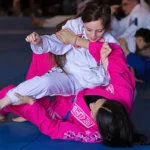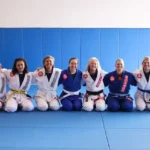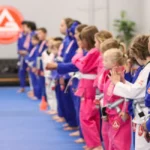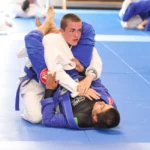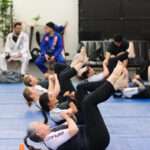Choosing a martial art is a personal journey. Whether you’re looking to boost your fitness, learn self-defense, or simply try something new, two of the most popular paths people explore are karate and Brazilian Jiu-Jitsu. But how do you know which one is the right fit for you?
At Gracie Barra West Jordan, we’ve helped countless students navigate that exact decision. And as Prof. Seidler Rodrigo always says, “There’s no one-size-fits-all answer, only what feels right for your goals and your spirit.”
In this article, we’ll break down the key differences between karate and Jiu-Jitsu, explore their histories, and help you understand which path might lead you to your best self.
The Origins and Philosophy of Karate
Karate began in the Ryukyu Kingdom, modern-day Okinawa, Japan, hundreds of years ago. Influenced by Chinese martial arts, it evolved into a disciplined system of striking techniques that includes powerful punches, sharp kicks, and quick defensive moves. Over time, karate spread throughout Japan and the world, eventually becoming an Olympic sport.
Philosophically, karate is deeply rooted in respect, honor, and perseverance. Practitioners bow to their instructors and training partners, reinforcing a culture of humility and gratitude. The movements are often practiced in patterns called katas, which develop not just technique but also focus, timing, and rhythm. These structured forms are more than just drills, they’re a way to pass down tradition and mental discipline through generations.
Students who are drawn to precision, structure, and the striking arts often find karate incredibly rewarding. It helps develop balance, reaction time, and confidence, especially for children and teens looking to channel their energy in a positive, respectful environment.
The Evolution and Essence of Brazilian Jiu-Jitsu
Brazilian Jiu-Jitsu (BJJ) traces its roots back to Japan, where it evolved from traditional jiu-jitsu and later influenced judo. When Japanese martial artist Mitsuyo Maeda immigrated to Brazil in the early 1900s, he brought with him a system of grappling and submission that would soon take on a life of its own.
It was in Brazil that this art was truly transformed. The Gracie family, most notably brothers Hélio and Carlos Gracie, adapted and refined the techniques to better suit their physical limitations and strategic mindset. Instead of relying on strength, they emphasized leverage, timing, and body positioning, elements that allowed smaller individuals to overcome larger opponents. Their approach gave birth to what we now know as Brazilian Jiu-Jitsu.
Over the decades, Jiu-Jitsu became more than just a self-defense method. It became a way of life, teaching resilience, patience, and problem-solving under pressure. This spirit lives on today in schools around the world.
Master Carlos Gracie Jr., son of Carlos Gracie, played a key role in spreading Brazilian Jiu-Jitsu globally. Through his visionary work as the founder of Gracie Barra, he built not only a network of exceptional instructors but also a platform that made Jiu-Jitsu accessible to people from all walks of life. His efforts helped transform Brazilian Jiu-Jitsu into the inclusive, empowering discipline it is today.
Comparing Karate and Jiu-Jitsu: What Sets Them Apart?
When choosing between karate and Brazilian Jiu-Jitsu, it’s important to look beyond surface-level differences. Each art offers something valuable, and both can help individuals become stronger, more focused, and more confident. But the way they teach those lessons, and the experiences they offer, are quite distinct.
Karate tends to attract people who appreciate structure, striking power, and traditional discipline. It offers clear, precise movement patterns and a strong foundation in personal conduct and respect.
Jiu-Jitsu, on the other hand, often appeals to those who enjoy fluid, adaptive learning and the chance to test techniques against resisting opponents. It’s not about memorizing forms, it’s about solving problems in real time, using skill over strength.
To help you see the contrast more clearly, Prof. Seidler Rodrigo put together this side-by-side comparison:
|
ASPECT |
KARATE |
BRAZILIAN JIU-JITSU |
| Core Techniques | Emphasizes punches, kicks, and open-hand strikes | Focuses on takedowns, joint locks, chokes, and positional control |
| Typical Training | Repetition of forms (katas), striking drills, stance work, and shadow fighting | Drilling techniques, positional training, live sparring (rolling), and strategy development |
| Combat Style | Striking and distancing; opponents stay on their feet | Grappling and close-quarters control; often ends up on the ground |
| Fitness Benefits | Improves agility, speed, flexibility, and muscular coordination | Builds endurance, core strength, full-body control, and problem-solving under stress |
| Practical Self-Defense | Effective in striking-based situations; distance control is key | Highly effective in real-life situations that go to the ground or involve grappling |
| Mental Benefits | Reinforces patience, precision, and repetition | Enhances adaptability, humility, and calmness in dynamic situations |
Neither art is inherently better, it all depends on what resonates with you. If you love clean, fast strikes and structured routines, karate might feel natural. But if you’re more interested in realistic, fluid self-defense and constant problem-solving, then Brazilian Jiu Jitsu might be the better path.
Why Students at Gracie Barra West Jordan Choose Jiu-Jitsu
While we respect all martial arts, many of our students at Gracie Barra West Jordan ultimately find that Brazilian Jiu-Jitsu offers more of what they’re looking for, especially when it comes to self-defense, long-term growth, and community support.
In Jiu-Jitsu, progress is earned step by step, through consistent challenge, but not just through memorization. There’s a unique satisfaction in overcoming resistance, learning how to stay composed under pressure, and watching your technique improve through live practice.
It’s also a lifestyle. Our students come from all backgrounds, some start with no martial arts experience at all. Others transition from striking disciplines like karate because they want a more hands-on, real-world approach to self-defense. And for every student, the mats become a space of transformation.
Prof. Seidler Rodrigo puts it beautifully: “We don’t just train to fight, we train to grow. Jiu-Jitsu is about becoming the best version of yourself, little by little, every single day.”
Ready to Try a Jiu-Jitsu Class?
If you’re exploring your options between karate and Brazilian Jiu-Jitsu, we’d love to invite you to experience Brazilian Jiu Jitsu for yourself.
Join us for a free trial class at Gracie Barra West Jordan. See how it feels. Talk to our instructors, meet our students, and get a sense of what Jiu-Jitsu can bring to your life.
No pressure, just a supportive space to explore something new and empowering.
Book your free trial today and take your first step onto the mats. We can’t wait to welcome you.

